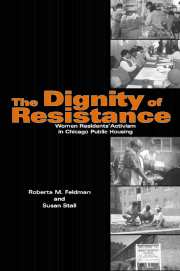Book contents
- Frontmatter
- Contents
- Foreword by Sheila Radford-Hill
- Preface and Acknowledgments
- PART I INTRODUCTION
- PART II WENTWORTH GARDENS' HISTORIC CONTEXT
- 2 U.S. Public Housing Policies: Wentworth Gardens' Historic Backdrop
- 3 Memory of a Better Past, Reality of the Present: The Impetus for Resident Activism
- PART III EVERYDAY RESISTANCE IN THE EXPANDED PRIVATE SPHERE
- PART IV TRANSGRESSIVE RESISTANCE IN THE PUBLIC SPHERE
- PART V CONCLUSIONS
- Epilogue
- Appendix A Timeline of Wentworth Gardens Resident Activists' Key Initiatives
- Appendix B A Demographic Profile of the Resident Community Activists Interviewed, 1992–1998
- References
- Index
2 - U.S. Public Housing Policies: Wentworth Gardens' Historic Backdrop
Published online by Cambridge University Press: 06 July 2010
- Frontmatter
- Contents
- Foreword by Sheila Radford-Hill
- Preface and Acknowledgments
- PART I INTRODUCTION
- PART II WENTWORTH GARDENS' HISTORIC CONTEXT
- 2 U.S. Public Housing Policies: Wentworth Gardens' Historic Backdrop
- 3 Memory of a Better Past, Reality of the Present: The Impetus for Resident Activism
- PART III EVERYDAY RESISTANCE IN THE EXPANDED PRIVATE SPHERE
- PART IV TRANSGRESSIVE RESISTANCE IN THE PUBLIC SPHERE
- PART V CONCLUSIONS
- Epilogue
- Appendix A Timeline of Wentworth Gardens Resident Activists' Key Initiatives
- Appendix B A Demographic Profile of the Resident Community Activists Interviewed, 1992–1998
- References
- Index
Summary
The U.S. federal government's assisted housing program was belated, irresolute, and very limited in extent (Vale, 2000). Compared with most other industrialized nations, America's 20th-century public housing programs have been insubstantial. Currently, less than 2% of Americans live in government subsidized housing developments, while rates of these other nations are at least 10 times higher. This small percentage of units cannot be explained by the lack of need for affordable housing. Estimates of the homeless and the underhoused – those living in dilapidated or severely crowded conditions – vary from the federal government's statistic of 5.3 million families (HUD, 1999), to 50 million reported by the Low Income Housing Coalition.
The U.S. government's reluctance to become involved in public housing is deeply rooted in the American political system (Jackson, 1995; Nenno, 1996). Federal housing policies, on the whole, have favored the private real estate industry (Jackson, 1995). Initially government programs encouraged homesteading through the direct provision of land and, more recently, home ownership through tax incentives, especially of single- family dwellings. Today, subsidies given through tax abatement for home ownership mortgages far outweigh the cost of all federally subsidized public housing programs (Jackson, 1985).
When the federal government finally did get involved in supporting public housing, it left little choice for the residents. In particular, the government determined where projects were sited, what types of households were eligible for tenancy, and what the income and race of the occupants would be.
- Type
- Chapter
- Information
- The Dignity of ResistanceWomen Residents' Activism in Chicago Public Housing, pp. 25 - 58Publisher: Cambridge University PressPrint publication year: 2004



